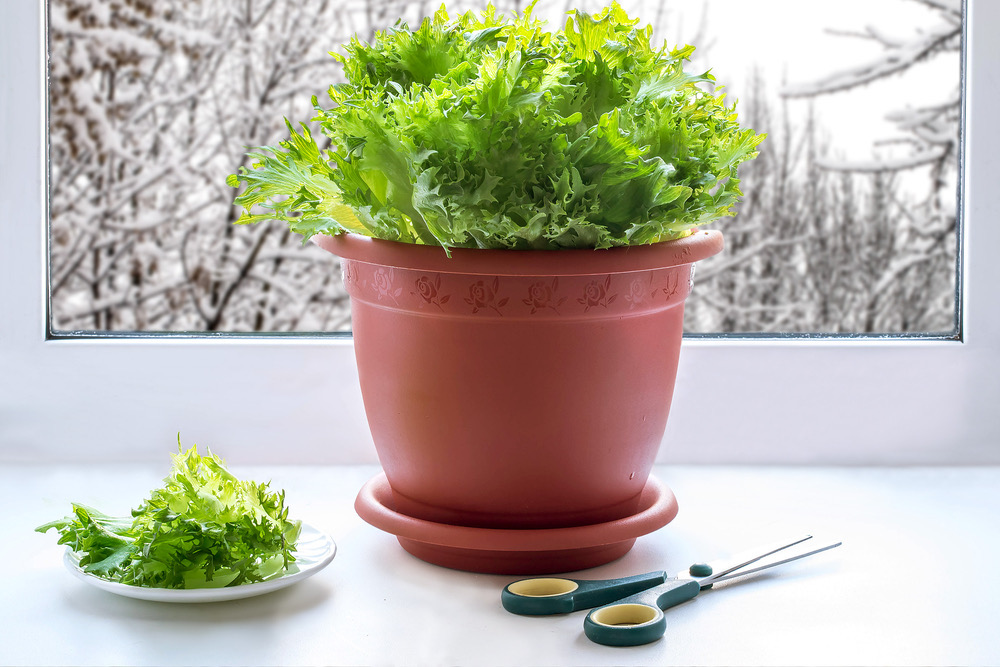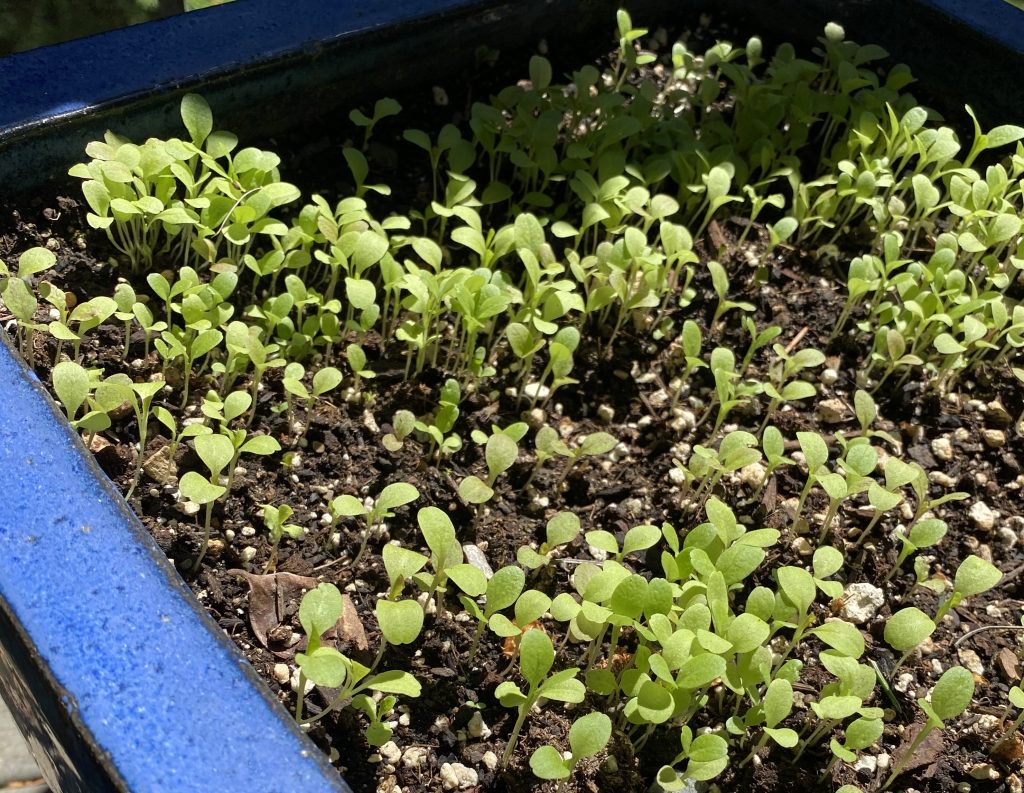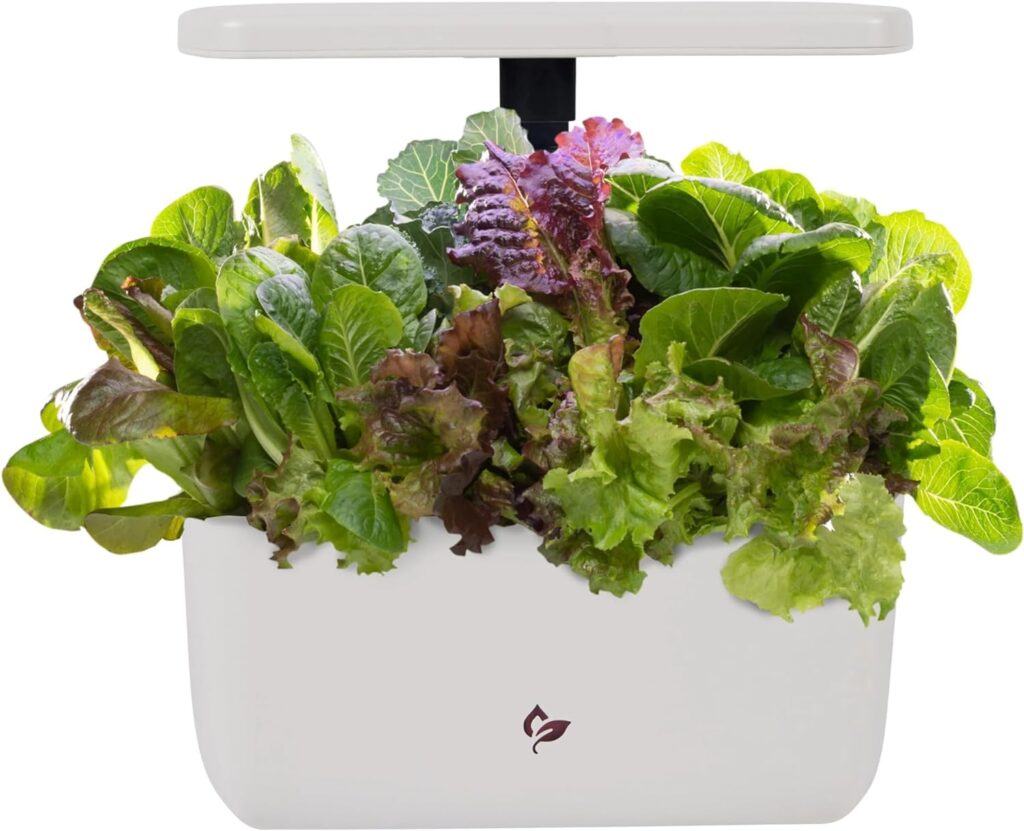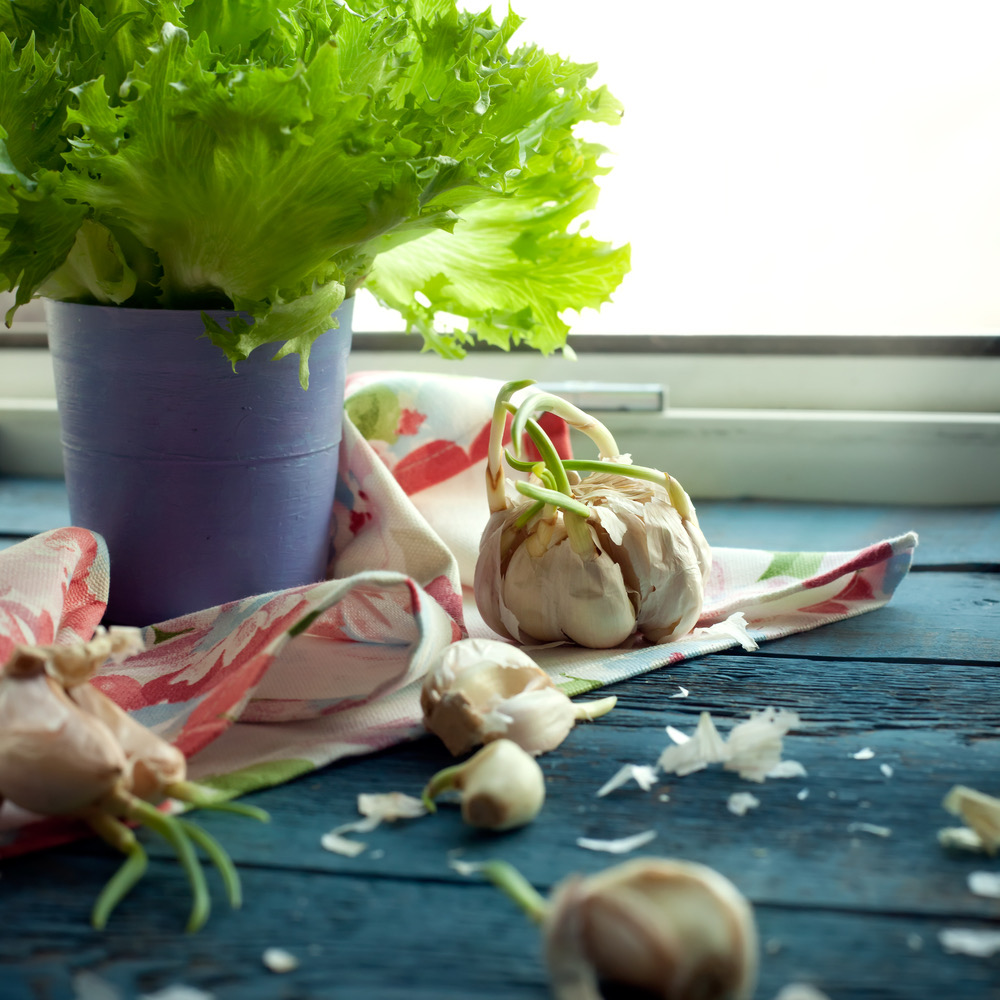Why Plant Indoors?
We actually have a large yard but there are so many pine trees that we don’t have enough sun for even a small garden. Because of this, we do a bit of container gardening and whatever else we can grow indoors!
If you don’t have a lot of space outside for a garden, or you’re just not that interested in digging up a big chunk of your lawn, the good news is you don’t have to. There are many things you can grow inside on your kitchen counter or in a sunny window. Salad greens are one of them.
Why Grow Your Own?
Salads make great summer meals and are a tasty addition to your lunchbox or dinner table any time of the year. They make the perfect light meal and leafy greens are healthy as they have vitamin K, anti-oxidants, low carbs, low calorie, and a low glycemic index.
They Taste Better
Let’s start with the obvious one first. Homegrown salad just plain tastes better. It is fresh; it has been grown in good soil (that you choose), and it hasn’t been washed, sprayed, and processed days before it makes it on your plate.
If you need a little more convincing get your hands on some fresh lettuce from a gardening friend or your local farmers market. You’ll be ready to grow your own after the first bite.
You Control The Quality And Variety
One of the best parts of growing your own produce is that you control what goes in the soil and the plants. And you get to pick what varieties you want to grow. That means you have a lot more options than what your local grocer offers.
Grocery store produce varieties (although there are many more choices now) are grown for easy and uniform growth and longer shelf-life. Flavor and nutrition aren’t the main concerns. The opposite is true when you grow your own. You can pick varieties that taste amazing, but may not last more than a few hours in the fridge after you harvest them.
It’s Healthier
Last but not least, your home-grown salad will be a lot healthier. Nutrients quickly start to deteriorate after produce is harvested. When you grow your own, you can go from soil to table in less than an hour. It doesn’t get any fresher than that, which means you get more of the vitamins in your food.
Plus since you control the soil, the additives, and anything that happens to the plans while they grow, you can limit your exposure to pesticides, insecticides and the likes. When you grow organic, you know it actually is organic.
How to Begin
The nice thing about lettuce is that most varieties don’t need a lot of space or soil to grow and they grow fairly fast. Lettuce also tends to grow well in temperatures that we’re most comfortable at in the house. As long as you find a nice sunny spot for your lettuce it will do well.
You’ll need:
- A Container or Bowl
- Soil
- Seeds or Seedlings
- Water
*One of the simplest ways to start if you just want to try this out is to cut off the ends of your romaine lettuce from the store and sit them in a cup or container with a little water. Leave it in there for about a week or until you start to see new green growth coming from the cut end, and roots forming at the bottom. Once those roots are about an inch or two long, plant your new lettuce plant into a bowl or small pot filled with potting soil. Keep it watered and in a sunny window and watch your lettuce grow. You can cut and regrow more lettuce several times.
Another fun option is to get lettuce seedlings at your local home and garden center. They will usually keep them stocked in the spring and depending on your local growing season again in late summer or early fall. Again, just grab a pot or an old bowl, fill it with good potting soil and plant your lettuce. It won’t take long before it grows enough that you can start to harvest.
Of course, you can grow any lettuce variety from seed. Take a look at the seed packets your local garden center has available (usually year-round), or order them online. Pay attention to germination time (and temperature), and how long it will take your lettuce to grow to maturity. One of my favorites is a gourmet lettuce blend
A completely different indoor option is to grow your greens in a hydroponic system. I had a lot of success with the AeroGarden system and used two of them for several years. The bonus with this system is that is comes with LED lights so you can grow year-round. Of course, there are several hydroponic systems that you can purchase or if you’re more adventurous, you can set up your own. To learn more about hydroponic lettuce gardening, see this article on Little Green Yard.
It is also helpful to know if you can continually harvest your lettuce varieties or if you should let it grow to maturity, harvest, and then replant. Start with something that’s easy to grow and take care of, then branch out from there.
Once you see those first few harvests and get a chance to eat your own salad, you’ll be ready to expand your lettuce bowl collection.
Choosing the Right Container
You can repurpose an old traditional salad bowl to grow your lettuce in. Glass bowls don’t work as well since it’s impossible to add drainage holes in the bottom. Your wooden bowls should work well though as do ceramic planter bowls or even pots you’re no longer using for potted plants.
Lettuce plants don’t have very deep roots, which is why shallow bowls work perfectly for planting them indoors. And since it won’t get super-hot – even in a sunny window- you don’t need a large amount of soil to retain moisture.
To get started, get a nice shallow planting bowl and a bag of quality potting soil that includes a slow-release fertilizer appropriate for vegetables. Or if you’re composting already (see the article I wrote on getting started), well-aged compost would make a rich organic way to fertilize your lettuce.
Once you have your bowl or pot, fill it with potting soil, and plant your salad and salad fixings. A salad or lettuce bowl can include several different varieties of lettuce and a few of your favorite herbs if you have a large enough container. Or you can divide everything up in several different containers as I do and grow a small tomato plant and a few green onions as well. Mix and match as you see fit, depending on what you like to eat.
That’s the fun of growing your own food. You can try different varieties and combinations until you come up with the one that works best for you. Along the way, you get to sample and try different varieties of lettuce your local market doesn’t offer. I just wouldn’t recommend iceberg lettuce as it has very few nutrients and takes up a lot of space.
Types of Greens to Grow in Your Salad Bowl
You can grow just about any type of lettuce in your salad bowl. That being said, there are some varieties that lend themselves to ongoing growing and harvesting. But let’s not put the cart before the horse. The size of your bowl and how many bowls you want to have sitting around determine what type and how much lettuce you can grow. Or flip that around and figure out how much lettuce you want per week and then figure out how many bowls it will take to keep you from heading to the grocery store.
If you’re new to this, you may want to keep it simple and start with one planting bowl. See how you like growing your own lettuce on your kitchen counter or your patio. If you find you’re eating the green leaves as fast as they can grow, consider adding another bowl or two.
Let’s go back to what you can grow in fairly small containers indoors. Loose-leaf lettuce is often your best bet when you want to be able to continually harvest greens for your salads. You can pick up seedlings at your local garden center and plant a few different varieties in your bowl. Or pick up a few different pack of seeds, divide the bowl into sections and sprinkle seeds from each variety in a different area of the bowl. Not only will using different varieties make it look pretty, each plant grows at slightly different rates and has different nutrients, helping you make the most out of your salad bowl.
Start with a few different varieties of loose-leaf lettuce like oak leaf, butter oak, red sails, or the aptly named red salad bowl. Romaine lettuces also work well and will regrow after you cut the leaves. If you like a slightly peppery taste, don’t forget about arugula.
Of course, you’re not limited to just loose-leaf lettuce. You can also grow spinach, green onions and various herbs in containers inside. You can even grow some radishes to cut up and add to your salad.
Mix and match varieties until you find a combination that grows well for you and is something you like to eat. Water your plants, fertilize occasionally with organic fertilizer and refresh the soil every few months. If you harvest and replant on an ongoing basis, you may never run out of fresh lettuce for your kitchen table.
When and How to Harvest
Loose-leaf lettuce also has the advantage of putting out more growth if you carefully harvest the leaves. To harvest the leaves, wait until the outer leaves reach a length of two to three inches. Use scissors to carefully cut the leaves, then rinse them in cool water and spin them dry with a salad spinner. I like this one because it’s collapsible. They will keep in the fridge for several days. I wrap mine in paper towels to extend the freshness. Wait for 2 to 3 days before you cut the same plant again.
Work your way around the lettuce bowl, harvesting every couple of days, then move on to the second bowl and give the first a little extra time to recover. Make sure your plants thrive with plenty of sunshine, just the right amount of watering, and the occasional bit of fertilizer if needed to keep the plants growing strong.
As your plants start to grow bigger and crowd each other out, it may be advantageous to thin them. Harvest entire loose-leaf lettuce plants to give the remaining plants in your bowls room to spread out. As you do this, take the time to throw in some seeds, or start fresh lettuce seedlings in a new container. Your main plants will continue to grow and produce more greens for you and your family.
Eventually, the lettuce will start to bolt. You’ll notice that the middle part will grow taller and it starts to form flowering stalks. (Cilantro does this very quickly!) At this point, your lettuce leaves will start to get tough and bitter. It’s time to harvest and remove these plants. If you’ve planted seeds in the bowl previously, you should have plenty of little lettuce plants coming up to take the place of the old ones. If you’ve been growing seedlings in the different containers, now is the time to plant them in your main salad bowls provided they are large enough.
Salad bowls are also an excellent tool to help teach your children about where our food comes from and how it is grown. I remember when I took my daughter to Canada to visit relatives, we pulled a carrot from the garden at my AUnt’s house. She looked at it and exclaimed, “How did THAT get in there!” Get the little ones involved in planting and caring for the lettuce plants. Not only is it a great learning experience, but it’s also a wonderful way to get them to eat more greens. After all, they’ve grown this lettuce.
Not Just Lettuce: Other Salad Fixings Can Be Grown Indoors
For several years, I used 2 Aerogardens in my house to grow my herbs and tomatoes. For some reason, I got tired of them and sold them at a garage sale but they did work well, and it was especially nice to have fresh herbs in winter. *Cilantro never did very well in the Aerogarden but it is hard to keep growing anyway!
But let’s take a look at various other “salad fixings” that you can grow indoors or on your patio in the warmer months. They make great additions to your salads but also come in handy in the kitchen in a multitude of other recipes.
Herbs
You can spend a small fortune on fresh herbs at the grocery store. Why not grow your own instead? You can keep them in small pots or other decorative containers. Actually, little planters are preferable since they have drainage holes, but use what you’ve got and just think of how pretty these little pots of herbs will look all lined up in your kitchen window.
Popular herbs to grow and use in your salads include:
- Basil
- Mint
- Parsley
- Cilantro
- Chives
- Rosemary
- Oregano
- Thyme
- Sage (more for cooking than salads)
… and more. Like lettuce, you can either grow them from seed or pick up small plant seedling at your local garden center.
Sprouts
Sprouts also make a great addition to your salad. They provide a little crunch and a lot of extra nutrients. But like herbs, they can be pricey if you pick them up at the store each week. Instead, order some seeds online, then sprout your own in a shallow container lined with moist paper towel. Sprouting is surprisingly quick and easy. The biggest secret is that you have to keep the seeds moist and warm. You can also buy sprouting kits which I like to do because I seem to get more control that way.
Common things to sprout include alfalfa, peas, beans, rye, radish, and broccoli. Start with the sprouts you like to eat, then expand your growing horizon from there.
Tomatoes And Peppers
Tomatoes and peppers may not be the first thing that comes to mind when you’re thinking about growing plants indoors, but there are small varieties that do surprisingly well in a sunny window. Of course, growing them outside on a patio or balcony in larger containers is also an option.
In either case look for varieties that don’t grow very large and provide a nice little harvest. You should be able to find varieties of tomatoes (mostly cherry tomatoes) and various peppers from hot to sweet that you can grow in a small space and add to your salad.
Not only do they add a nice burst of flavor and visual appeal to your salad, they also make pretty good houseplants. And isn’t it more satisfying to grow a plant that also provides you with food?
Onion and Garlic
If you’re feeling a little adventurous, try growing your own onion and garlic alongside your lettuce bowl. While regular onions don’t lend themselves to indoor growing you can plant green onions (scallions) and garlic bulbs and grow both of those in fairly small containers on your counter. Use the green onion, and you can even use the green stalks of the garlic plants in a similar way. It has a mellow bit of garlic flavor that’s not quite as strong as the garlic bulbs that will be growing all along in the soil.
Ready to give it a try? Head to your local garden center and grab your supplies! Or click on my links within the article to purchase from Amazon.
LEARN TO LOVE YOUR LIFE AGAIN
 Do you feel like you need to hit the REFRESH button on your life? Download our free guide and begin to create your best life yet!
Do you feel like you need to hit the REFRESH button on your life? Download our free guide and begin to create your best life yet!










Thank you for this article – so thorough! While I grow some herbs in pots, I never thought to grow lettuce! Cant wait to try.
Wow! This is a wonderful article,
I have a large clay pot beside my back porch in which I grow a variety of herbs. But, I never though of adding more pots with different salad plants.
I love the beauty of the pots placed together.
Great advice. It’s winter here and I have some rocket in a pot that’s stopped growing. I could bring that inside, yes?
If it’s in a pot, sure! Just place it in an area where there is plenty of light and don’t forget to harvest about every 33-4 days, maybe a bit less in winter.
Thank you! It’s fun to combine the textures, shapes and colors! I trim and dehydrate my herbs about every 3 weeks so that I have more freshly dried herbs.
It works really well. If you’re growing from seed, just remember to thin between the seedlings to get better growth.